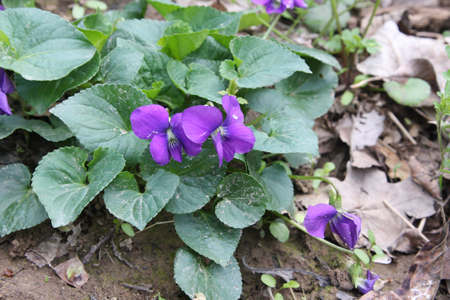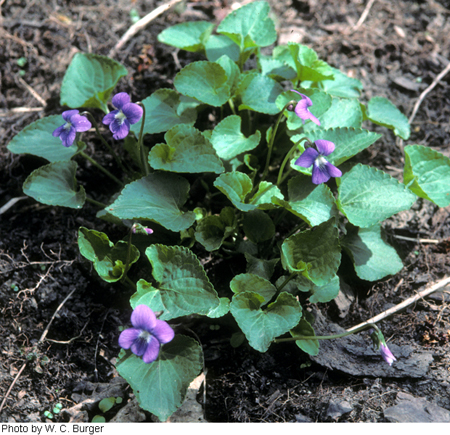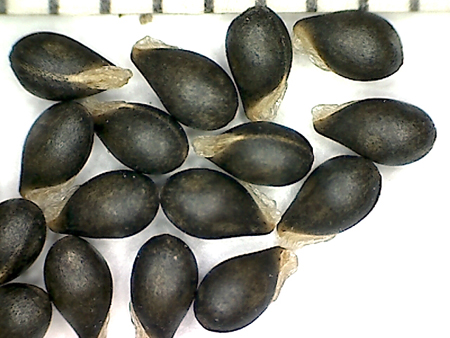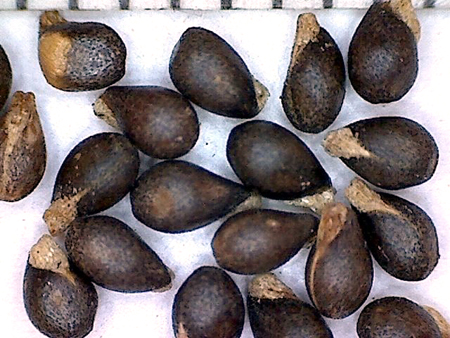Viola communis Pollard f. communis
Common names:
Common Blue Violet, Dooryard Violet, Hooded Blue Violet, Meadow Violet
Synonyms:
Viola communis Pollard, Bot. Gaz. 26: 336. 1898; Viola domestica E.P.Bicknell var. communis (Pollard) Farw., Pap. Michigan Acad. Sci. 2: 30. 1923 ["1922"]; Viola familiaris Greene, Cybele Columb. 1: 14. 1914. TYPE: unknown. [Pollard cited no types or specimens, but Taxonomic Literature II states that his herbarium and types are at US, with duplicates elsewhere. The US specimen database yielded no Pollard specimens of V. communis.]
Viola papilionacea sensu Brainerd, Russell and others, in part
Description:
Same as the species (see V. communis), but corolla blue to purple, lacking a conspicuous contrasting eyespot around the throat.
Ecology:
Same as the species.
Distribution:
Same as the species.
Rarity:
None.
Phenology:
Same as the species.
Hybrids:
Reports of hybrids involving "V. papilionacea" and other species probably refer to this [or possibly V. "sororia glabrous" or V. "sororia hirsutula-like"]. They include hybrids with V. affinis (House 1906b, 1924, Brainerd 1924), V. brittoniana (Dowell 1910, Brainerd 1924, House 1924), V. cucullata (Brainerd 1906b, 1924, House 1924), V. emarginata (House 1906b, 1924, Brainerd 1924), V. fimbriatula (Stone 1903, Brainerd 1906b, 1924, House 1924), V. hirsutula (House 1906b, Brainerd 1907a, 1924, Henry 1953a), V. lovelliana (Brainerd 1924), V. nephrophylla (Brainerd 1924), V. palmata var. triloba (Brainerd 1912, 1924), V. sagittata (Brainerd 1906b, 1924, House 1924), V. sororia sensu stricto (Dowell 1910, Greene 1914, Brainerd 1924, Henry 1953a), V. stoneana (Brainerd 1912, 1924), and V. subsinuata sensu stricto (Dowell 1910, Brainerd 1912, 1924, House 1924). The actual parentage of these hybrids (with regard to which sororia-like taxon was involved) needs to be established beyond doubt. Brainerd reported that these exhibit intermediate or recombinant characteristics of foliage, chasmogamous flowers, cleistogamous capsules and seeds (where these did not abort). All hybrids fail to reproduce by chasmogamous flowers, and the cleistogamous capsules are abortive or produce a drastically diminished proportion of viable seeds. I have seen frequent hybrids of the present taxon with V. affinis and with V. sororia sensu stricto sporadically throughout Athens County, Ohio. These exhibit the traits Brainerd reported in nearly all other hybrids of acaulescent blue violets.
Comments:
See comments under the species.
Literature Cited:
Brainerd, E. 1906b. Hybridism in the genus Viola,-III. Rhodora8: 49-60, plates 66-70.
Brainerd, E. 1907a. The behavior of the seedlings of certain Viola hybrids. Science 25: 940-944.
Brainerd, E. 1912. Violet hybrids between species of the palmata group. Bulletin of the Torrey Botanical Club 39: 85–97.
Brainerd, E. 1913a. Four hybrids of Viola pedatifida. Bulletin of the Torrey Botanical Club 40: 249-260.
Brainerd, E. 1924. The natural violet hybrids of North America. Vermont Agricultural Experiment Station Bulletin 239: 1-205.
Dowell, P. 1910. The violets of Staten Island. Bulletin of the Torrey Botanical Club 37: 163–179.
Greene, E. L. 1903a. The genus Viola in Minnesota-I. Pittonia 5: 115-133.
Greene, E. L. 1914. Violets of the District of Columbia.-1. Cybele Columbiana 1(1): 7-33.
Haines, A., E. Farnsworth, and G. Morrison. 2011. Violaceae. In Flora Novae Angliae. Yale University Press, New Haven, CT. 873-886.
Henry, L. K. 1953a. The Violaceae in western Pennsylvania. Castanea 18(2): 37-59.
House, H. D. 1906b. The violets and violet hybrids of the District of Columbia and vicinity. Rhodora 8: 117-122, plates 71-72.
House, H. D. 1924. Annotated list of the ferns and flowering plants of New York state. Family 83 Violaceae. New York State Museum Bulletin 254: 499-512.
Stone, W. 1903. Racial variation in plants and animals with special reference to the violets of Philadelphia and vicinity. Proceedings of the Academy of Natural Sciences of Philadelphia 55: 656-699, plates 31-39.

Chasmogamous flowering habit by Bruce Sorrie

Chasmogamous flowering habit by W. C. Burger, Morton Arboretum, SERNEC portal

Leaves between chasmogamous flower and fruit by Harvey Ballard

Seeds from herbarium specimen: Transplanted from OH, Athens Co., Waterloo Wildlife Area, H. Ballard 17-023B (BHO)

Seeds from herbarium specimen: Transplanted from IL, E. Brainerd 160 (NY)